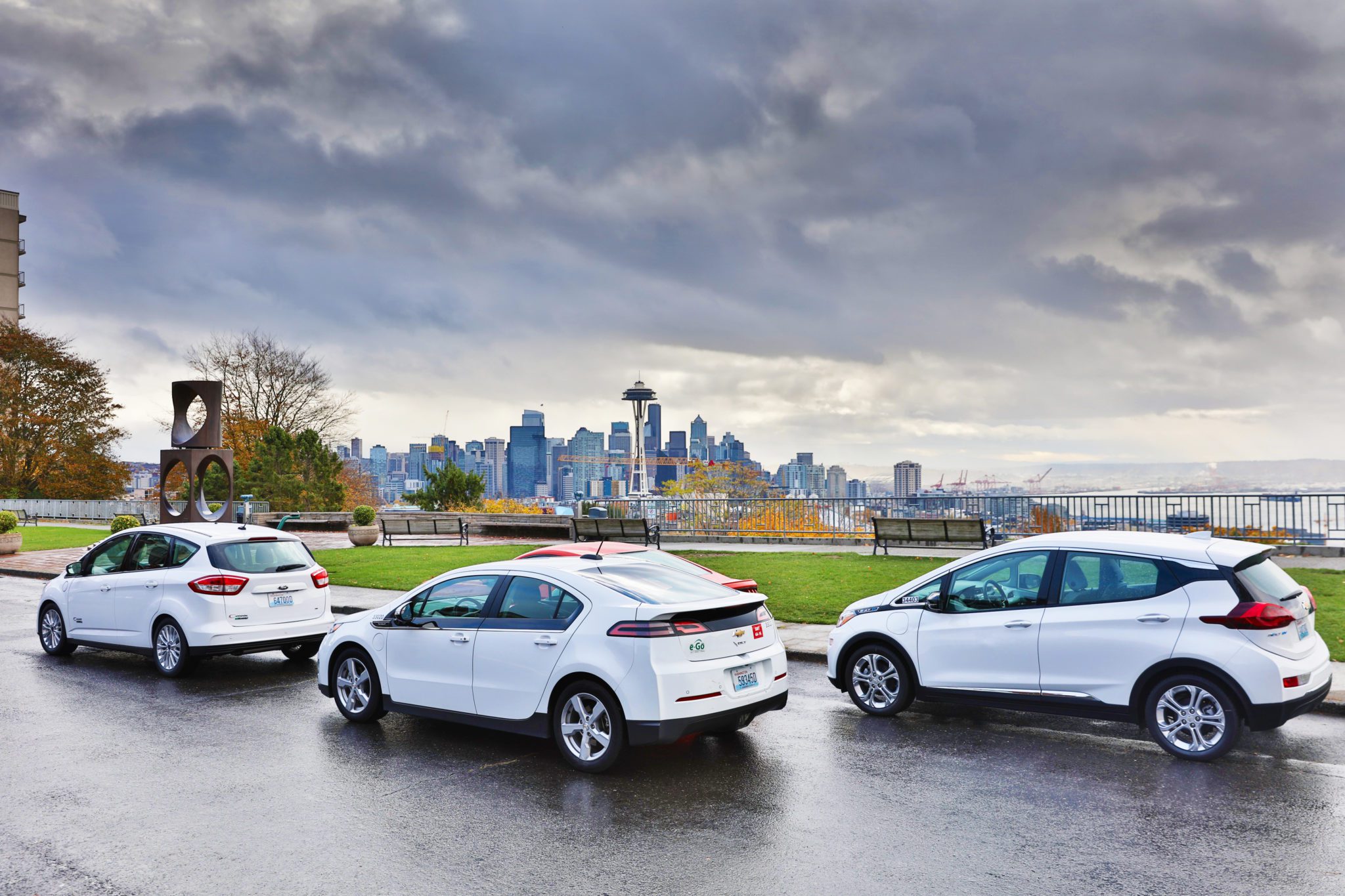
Transportation is Seattle’s leading cause of climate pollution. It accounts for nearly two thirds of the City’s Greenhouse Gas (GHG) emissions. Unsustainable transportation pollutes air and water ways and disproportionately affects Black, Indigenous and People of Color (BIPOC) populations.
In 2021, the City of Seattle released the ambitious Transportation Electrification (TE) Blueprint. It’s goal is to significantly reduce emissions by 2030 and move Seattle’s transportation sector toward a clean, equitable future. Since then, City Light has been working with several City departments to achieve the ambitious goals of the TE Blueprint by 2030.
We are proud to present the second annual TE Blueprint Action Report, a testament to the progress we’ve made together over the past year.
100% of Shared Mobility Is Zero Emissions
Goal: As shared mobility services like bikes, scooters, taxis, Uber, Lyft, carshare services, and others continue to expand in Seattle, the City will ensure those operations are electric and emissions free.
Seattle launched Washington’s first-ever electric van share in June 2023, which is accessible in alignment with the Americans with Disabilities Act (ADA).
Seattleites also took 4.8 million rides on electric-assisted scooters and bikes in 2023, surpassing the City’s goal of 4 million rides!
90% of All Personal Trips Are Zero Emissions
Goal: To reach our climate goals, by 2030 nine out of ten trips must be taken by walking, biking, electric transit or in an electric vehicle (or avoided all together).
In 2023, City Light, WSDOT, MTR Western, and Amtrak partnered to launch the United States’ first electric regional bus. The bus connects Seattle and Bellingham and will eliminate 109 metric tons of CO2 emissions annually.
SDOT and King County Metro partnered to create the Flip Your Trip Center City campaign, which focuses on increasing transit ridership and reducing GHG emissions. Participants in the program will pledge and receive $25 in credits for transit, scooter, and bike share. So far, more than 2,000 participants have flipped over 13,000 individual trips, significantly reducing individual carbon footprints!
30% of Goods Delivery Is Zero Emissions
Goal: As more and more of the goods we buy and the food we eat are purchased online, we are seeing growing congestion and pollution from transportation. This goal is aimed to spur the transition of private fleets to EVs, following the same goal for personal vehicles, over the next 10 years.
Last summer, OSE launched the Heavy Duty Vehicle Electrification Incentive Pilot, which provides point-of-scale rebates to help drivers operating in the Duwamish Valley, many of whom are African immigrants and face high up-front transition costs and limited access to credit, trade in their diesel truck for new electric vehicles (EVs).
In 2022, City Light started the Fleet Electrification Program, which makes it easier for businesses to transition into using electric vehicles. This program has assessed more than 1,400 fleet vehicles and will save a potential 60,000 metric tons of GHG emissions in the future.
SDOT is developing a new commercial e-cargo bike program that will launch in 2024. The program will include guidelines and tools for e-cargo bike standards, a new permitting system, and dynamic use of curb space for cargo bike parking and loading. SDOT is also exploring ways to cut emissions in curb delivery loading zones.
100% of Fleet Is Fossil-Fuel Free (Executive Order 2018-02)
Goal: Continuing to lead by example, Seattle will operate a large municipal fleet with zero fossil fuels by 2030.
In 2023, SDOT tested an EV sweeper to clean protected bike lanes. Other demonstrations and pilots have included deploying all-electric forklifts and rollers, deploying rented or borrowed EVs in partnership with vendors to assess their real-world service delivery performance, and testing drop-in renewable diesel in city vehicles as a more environmentally friendly alternative to conventional fossil fuels.
One or More “Green & Healthy Streets” in Seattle
Goal: Seattle will ensure a major area of our city will have zero emissions from transportation including streets or blocks that are closed to cars and promote walking, biking, electrified transit, and electric goods delivery and services.
In 2023, the US Department of Transportation invested $1.2 million in Seattle’s research and planning to implement three new low pollution neighborhoods by 2028. OSE plans on continuing to engage with residents in communities heavily impacted by pollution, flooding, extreme heat, and other climate change issues.
Electrical Infrastructure Required to Stay Ahead of Transportation Electrification Adoption Is Installed and Operational
Goal: Infrastructure investments will enable a rapid transition to an electrified transportation system. Seattle City Light will work strategically to make sure the grid is reliable and built out to enable rapid adoption for emerging electric transportation technologies and vehicles.
To meet this goal, City Light is installing Level 2 EV and DC fast EV chargers in locations across Seattle, including EV chargers in residential neighborhoods. Public demand has led to 31 new curbside EV charger locations, which were selected after reviewing more than 1,800 resident requests. City Light also launched a multifamily EV charging program that offers rebates to multifamily property owners to install EV charging stations at their properties. As of December 2023, 19 projects have been completed, with 154 properties in the program pipeline. This will help close the EV charging access gap for multifamily residents.
The progress Seattle has made in achieving the TE Blueprint’s goals puts us significantly closer to a clean and equitable future. To learn more about the progress being made, check out the 2023 TE Blueprint Action Report.